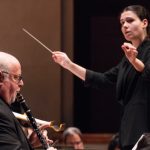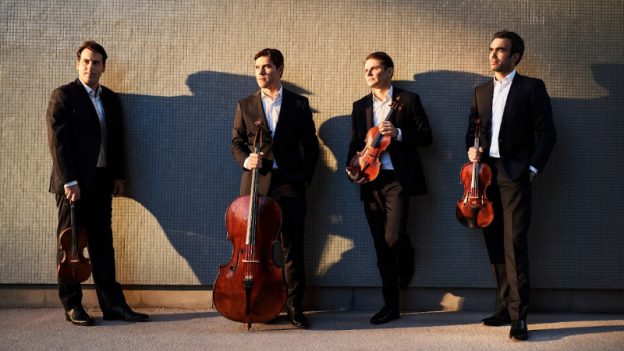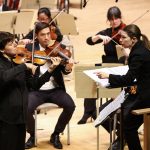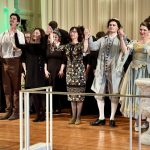November 18, 2025
Stude Concert Hall, The Shepherd School of Music
Houston, Texas – USA
Modigliani Quartet (Amaury Coeytaux & Loïc Rio, violins; Laurent Marfaing, viola; François Kieffer, cello).
Joseph HAYDN: Quartet in F major, Op. 77 No. 2(1799)
Ludwig van BEETHOVEN: Quartet in G major, Op. 18 No. 2 (1801)
Johannes BRAHMS: Quartet in A minor, Op. 51 No. 2 (completed 1873)
Lawrence Wheeler | 21 NOV 2025
On Tuesday, November 18, Chamber Music Houston featured the Modigliani Quartet at Rice University’s Stude Concert Hall. A CMH regular, the ensemble closed a nine-city U.S. tour with this performance.
In a somewhat lengthy pre-performance speech, we learned that this is CMH’s 66th season, with over 500 performances given to date. The obligatory request for contributions was pitched to a half-filled hall with a predominantly gray-haired audience. This raises questions about the organization’s sustainability in a world where classical music—especially chamber music—is experiencing declining audiences. A quick survey of tonight’s crowd showed few younger listeners, save for some of the music students fortunate to have had a chamber-music masterclass with the quartet that afternoon. I saw no Shepherd School of Music faculty at the concert, though some likely attended the masterclass. Perhaps the formula that has served CMH for six decades would benefit from reassessment. CMH has long been, and continues to be, an important part of Houston’s concert life and should remain so well into the future.
Tonight’s program consisted of three works by giants of the First Viennese School: Joseph Haydn’s last complete string quartet and the second quartets of Beethoven and Brahms. On the U.S. tour, the Modigliani performed these works alongside Beethoven’s Op. 18 No. 1 and Op. 59 No. 3. Five of the tour programs also included Twelve Microludes by György Kurtág, but unfortunately not the Houston date. Concert sponsors are given some flexibility regarding repertoire choices; with many audience members being amateur musicians, the selected works were among those frequently encountered at home chamber-music readings. Since the quartet studied with Kurtág, the inclusion of his work would have been especially illuminating.
Haydn’s String Quartet in F major, Op. 77 No. 2 is his last completed quartet. Though not as widely known as his six Op. 76 quartets, it contains all the brilliant inventiveness, charm, and wit characteristic of his finest contributions to the genre. The Modigliani offered a tonally beautiful, if musically straightforward, reading.
The opening movement held few surprises, except perhaps how effortlessly Coeytaux dispatched the challenging first-violin part. The quartet brought out the off-beat rhythms of the “Presto” second movement—a “Menuetto” in name only, functioning very much as a scherzo. Adding to the humor is a “Trio” in D-flat major, followed by the main theme first whispered in that remote key before the “Scherzo” returns in an instant—presto chango. One can almost hear Haydn chuckling as he wrote it. The third-movement “Andante,” a set of variations beginning with a violin–cello duet, allowed each player a turn with the theme. The “Finale,” with its rhythmic and harmonic twists, was executed with consummate flair.
Beethoven’s six Op. 18 quartets show Haydn’s influence but surpass the elder composer with a fuller harmonic and tonal palette. His democratic distribution of material creates a wider range of expression than Haydn’s more first-violin-centered writing. Beethoven’s works would soon reflect the political and societal upheavals overtaking Europe. His String Quartet in G major, Op. 18 No. 2, shares much with Haydn’s Op. 77 No. 1: both are in G major, both were dedicated to Prince Joseph Lobkowitz, and both earned the nickname “Compliment” (or “Curtsey”) Quartet.
The Modigliani gave a brilliant and impeccably balanced performance. The first movement sparkled with precision and energy. The following “Adagio cantabile,” the quartet’s only slow movement, showcased Coeytaux and his 1715 Stradivarius—producing sounds at times almost unbearably beautiful. The middle “Allegro” section, with its awkward uneven bowings, was handled flawlessly. The Scherzo’s “giddy-up” motif offered a dose of Haydnesque humor, while the Trio featured deft trading of triplet figures. The concluding “Allegro molto, quasi presto” was delivered with virtuosic abandon and unmistakable joy.
Brahms’ String Quartet in A minor, Op. 51 No. 2, is far more lyrical than its C-minor companion. This contrast was heightened by the Modigliani’s approach, which favored transparency over weight, emphasizing the many softer dynamic markings in the score. The opening theme, marked piano espressivo, was played by violinist Amaury Coeytaux with a tender, almost tentative tone. Violist Laurent Marfaing’s underplayed triplets masked their inherent difficulty, while violinist Loïc Rio joined Coeytaux seamlessly, and François Kieffer’s descending bass line grounded the ensemble.
From the outset, it was clear that this would not be a performance seduced by Brahms’s lush textures into constant full-throated intensity. Brahms’s markings—piano espressivo, piano dolce, molto piano, mezza voce, grazioso, dolce, lusingando (seductively)—indicate otherwise. The quartet’s balanced sonority lent intimate expression to the writing, with fully realized fortes providing necessary contrast. The repeat of the exposition was welcome.
The lyrical second movement, with its easygoing, almost folksong-like quality, was played with color and expressiveness by Coeytaux. The music soon enveloped the other players in dialogue before erupting into an operatic canon between first violin and cello, underpinned by vigorous tremolos in the middle voices. A tender apology followed, before a return to the dramatic canon. The quartet played with conviction and emotional breadth.
The “Quasi Menuetto” provided relief with an ascetic theme that sounded ancient after the previous movement’s intensity. Here, the quartet sought simplicity. The “Allegretto vivace” middle section, with its Mendelssohnian delicacy and extreme technical demands, was shaped with precision and lightness. The rhythmically intricate return to the “Minuetto” was cohesive and secure.
In the “Finale,” the quartet pulled out all the stops. The Hungarian-style dance rhythms include a hemiola theme against a triple-meter accompaniment. First stated by the violin, it is repeated by the viola, which Marfaing projected with uncommon clarity. This movement contains the work’s first fortissimos, to which the quartet responded with orchestral volume. It was a thrilling conclusion to an outstanding concert.
Following a standing ovation, the ensemble offered a substantial encore: the second movement of Beethoven’s String Quartet in F major, Op. 18 No. 1 (“Adagio affettuoso ed appassionato”). Inspired by the crypt scene from Shakespeare’s Romeo and Juliet, it was given tender expression and dramatic depth. A false entrance by Rio—surprising in music the quartet had been performing throughout the tour—served as a reminder that even world-class musicians are human. ■
EXTERNAL LINKS:
- Chamber Music Houston: chambermusichouston.org
- Modigliani Quartet: modiglianiquartet.com

Read more by Lawrence Wheeler.
RECENT POSTS
 Dallas Symphony’s assistant conductor rises to the challenge in a program of premieres and familiar works • 25 Nov 2025
Dallas Symphony’s assistant conductor rises to the challenge in a program of premieres and familiar works • 25 Nov 2025 Tyshawn Sorey Trio and Sandbox Percussion merge forces in Durham for an immersive night honoring jazz drummer Max Roach • 24 Nov 2025
Tyshawn Sorey Trio and Sandbox Percussion merge forces in Durham for an immersive night honoring jazz drummer Max Roach • 24 Nov 2025




.png)